
Night Sky Star Stories Makinak: The Turtle
We acknowledge the support of the Canada Council for the Arts.
- Subject:
- Astronomy
- English Language Arts
- Physical Science
- Social Science
- Material Type:
- Activity/Lab
- Date Added:
- 11/18/2024

Night Sky Star Stories Makinak: The Turtle
We acknowledge the support of the Canada Council for the Arts.
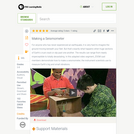
In this video segment adapted from ZOOM, cast members make a seismometer and experiment with different ways to make it register movement.
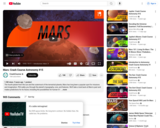
The fourth planet from the sun and the outermost of the terrestrial planets, Mars has long been a popular spot for missions and imagination. Phil walks you through the planet's topography, core, and features. We'll take a look back at Mars's past and makes predictions for its future, including the possibilities for human life.
Chapters:
Introduction: Mars
Mars is Red, Rusty, and Dusty
Surface Features of Mars
Mars's Polar Ice Caps
Martian Atmosphere
Martian Moons: Deimos and Phobos
Is There Water on Mars?
Was There Life on Mars?
Martian Missions
Review
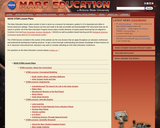
The Mars Education lesson plans section is here to serve as a resource for educators, grades K-12 to download and utilize in formal classroom settings.
For questions on the Mars Education Lessons please contact us.
All of the Mars Education Program lesson plans include elements of inquiry-based learning that are aligned to Common Core and Next Generation Science Standards (NGSS) as well as problem-based learning and the Biological Sciences Curriculum Study (BSCS) 5-E instructional model.
The STEM lessons included in this section of the website are the very lessons that we apply throughout our educator conferences and professional development training sessions.
To get a more thorough understanding and deeper knowledge of these lessons as an in classroom instructional tool, educators may want to consider attending an ASU Mars Education Conference.

This book contains 24 illustrated math problem sets based on a weekly series of space science problems. Each set of problems is contained on one page. The problems were created to be authentic glimpses of modern science and engineering issues, often involving actual research data. Learners will use mathematics to explore problems that include basic scales and proportions, fractions, scientific notation, algebra, and geometry.
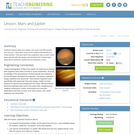
Students explore Mars and Jupiter, the fourth and fifth planets from the Sun. They learn some of the unique characteristics of these planets. They also learn how engineers help us learn about these planets with the design and development of telescopes, deep space antennas, spacecraft and planetary rovers.
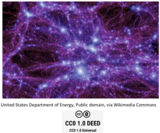
la matière noire est une forme de matière non lumineuse détectée par son interaction gravitationnelle. L'énergie sombre est une forme d'énergie qui semble conduire à l'expansion accélérée de l'Univers, dont la nature précise reste une énigme majeure pour la physique et la cosmologie contemporaines. Ces deux composants sont cruciaux pour comprendre la dynamique, la structure et l'évolution de l'Univers, mais ils sont encore largement mal compris et font l'objet de recherches intensives dans le domaine de l'astrophysique et de la cosmologie.Un cours "matière noire et l'énergie sombre" pourrait être une exploration passionnante des mystères les plus intrigants de l'Univers moderne. Il aborderait les concepts fondamentaux, les observations astrophysiques et les théories actuelles qui tentent de comprendre deux des composants les plus énigmatiques de l'Univers.
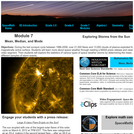
During the last sunspot cycle between 1996-2008, over 21,000 flares and 13,000 clouds of plasma exploded from the Sun's magnetically active surface. Students will learn more about space weather through reading a NASA press release and viewing a NASA eClips video segment. Then students will explore the statistics of various types of space weather storms by determining the mean, median and mode of different samples of storm events. This activity is part of the Space Math multimedia modules that integrate NASA press releases, NASA archival video, and mathematics problems targeted at specific math standards commonly encountered in middle school textbooks. The modules cover specific math topics at multiple levels of difficulty with real-world data and use the 5E instructional sequence.

This is a set of three, one-page problems about the size and area of solar panels used to generate power. Learners will calculate area fractions to compare the sizes and distances of Jupiter's moons. Options are presented so that students may learn about the Juno mission through a NASA press release or about how solar energy is used by various NASA satellites and technology by viewing a NASA eClips video [3 min.]. This activity is part of the Space Math multi-media modules that integrate NASA press releases, NASA archival video, and mathematics problems targeted at specific math standards commonly encountered in middle school.

The main aim of this lesson is to show students that distances may be determined without a meter stick—a concept fundamental to such measurements in astronomy. It introduces students to the main concepts behind the first rung of what astronomers call the distance ladder. The four main learning objectives are the following: 1) Explore, in practice, a means of measuring distances without what we most often consider the “direct” means: a meter stick; 2) Understand the limits of a method through the exploration of uncertainties; 3) Understand in the particular method used, the relationship between baseline and the accuracy of the measurement; and 4) Understand the astronomical applications and implications of the method and its limits. Students should be able to use trigonometry and know the relation between trigonometric functions and the triangle. A knowledge of derivatives is also needed to obtain the expression for the uncertainty on the distance measured. Students will need cardboard cut into disks. The number of disks is essentially equal to half the students in the class. Two straight drink straws and one pin per disk. Students will also need a protractor. The lesson should not take more than 50 minutes to complete if the students have the mathematical ability mentioned above. This lesson is complimentary to the BLOSSOMS lesson, "The Parallax Activity." The two lessons could be used sequentially - this one being more advanced - or they could be used separately.

Converting a visual to a tactile experience, this activity lets visually impaired students learn about and explore some of the characteristics of our home planet, the Earth.
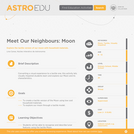
Converting a visual experience to a tactile one, this activity lets visually impaired students learn and explore our Moon and its characteristics.
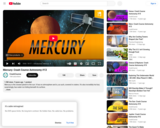
Mercury is the closest planet to the sun. It has no atmosphere and is, as such, covered in craters. It's also incredibly hot but, surprisingly, has water ice hiding beneath its surface.
Chapters:
Introduction: Mercury
Mercury's Orbit
Mercury's Rotation - Orbit Ratio
A Weird Day on Mercury
Mercury's Craters
Mercury's Internal Structure
Deep Crater Water Ice on Mercury
Review
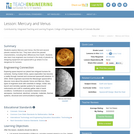
Students explore Mercury and Venus, the first and second planets nearest the Sun. They learn about the planets' characteristics, including their differences from Earth. Students also learn how engineers are involved in the study of planets by designing equipment and spacecraft to go where it is too dangerous for humans.
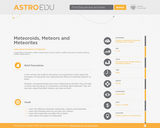
Students will experimentally learn how meteoroids are formed. They will melt a comet, learning about its composition, and break apart asteroids. The students learn the differences between meteoroids, meteors and meteorites and how the impact of asteroids/meteoroids can affect life on Earth.
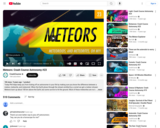
Today Phil helps keep you from ticking off an astronomer in your life by making sure you know the difference between a meteor, meteorite, and meteoroid. When the Earth plows through the stream emitted by a comet we get a meteor shower. Meteors burn up about 100 km above the Earth, but some survive to hit the ground. Most of these meteorites are rocky, some are metallic, and a few are a mix of the two. Very big meteorites can be a very big problem, but there are plans in the works to prevent us from going the way of the dinosaurs.
Chapters:
Introduction: Meteors
Shooting Stars, Meteoroids, Meteors, or Meteorites?
Kinetic Energy
Compression & Ablation
Sporadic Meteors
Meteor Showers
Bolides
Classifying Meteorites
Very Big Meteorite = Very Big Problem
Review

This lesson describes the history and basic operation of the metric system as well as scientific notation. The simplicity of the metric system stems from the fact that there is only one unit of measurement (or base unit) for each type of quantity measured (length, weight, etc.).
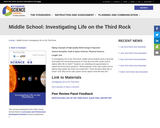
Rating: Example of High Quality NGSS Design if Improved
Science Discipline: Earth & Space Sciences, Physical Sciences
Length: Unit
In Investigating Life on the Third Rock, middle school students work to generate and explore the overarching question of “How does the solar system and its objects affect life on Earth?” Students use modeling and argumentation to explore the lesson-level questions: “What properties of the solar system and its objects help explain why Earth can sustain life?” “Does the Moon affect life on Earth?” and “Why do the solar system and its objects move like they do?”

How changes in Earth's rotation can effect Earth's seasons and climate. Created by Sal Khan.
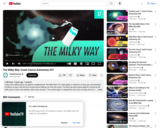
Today we’re talking about our galactic neighborhood: The Milky Way. It’s a disk galaxy, a collection of dust, gas, and hundreds of billions of stars, with the Sun located about halfway out from the center. The disk has grand spiral patterns, formed by the traffic jams of stars and nebulae, where stars are born. The central region is shaped like a bar and is mostly old, red stars. There’s also a halo surrounding us of old stars.
Chapters:
Introduction: The Milky Way
What is the Milky Way Galaxy?
The Milky Way's Shape
Spiral Arms of the Milky Way
Mapping the Milky Way
Outer Halo of the Milky Way
Review